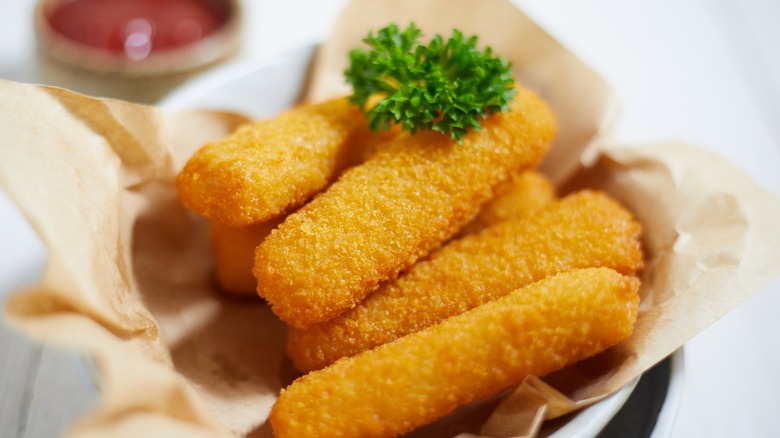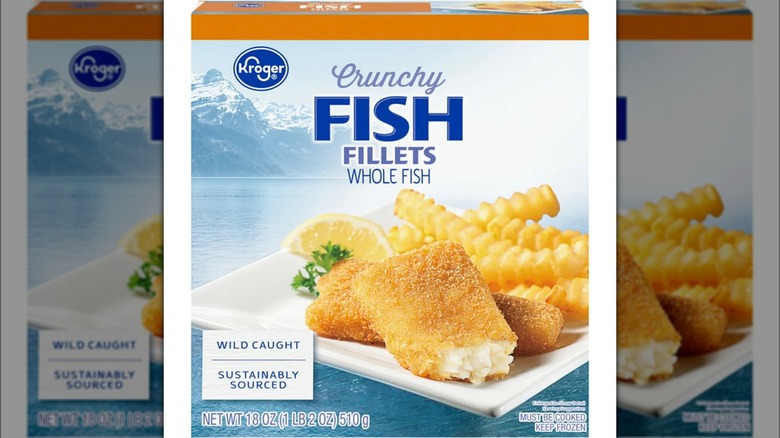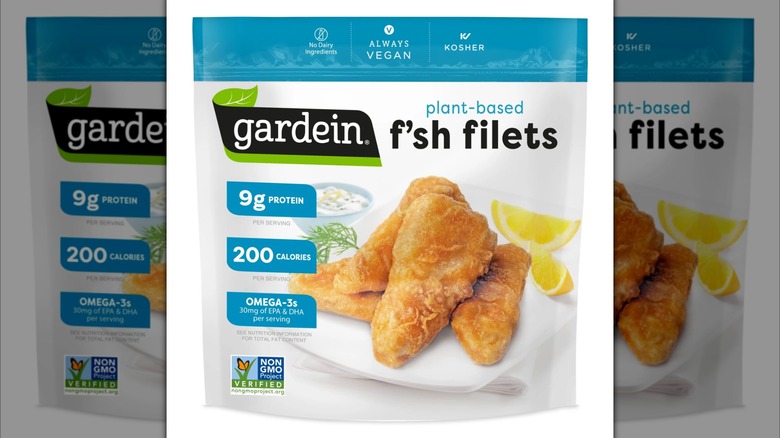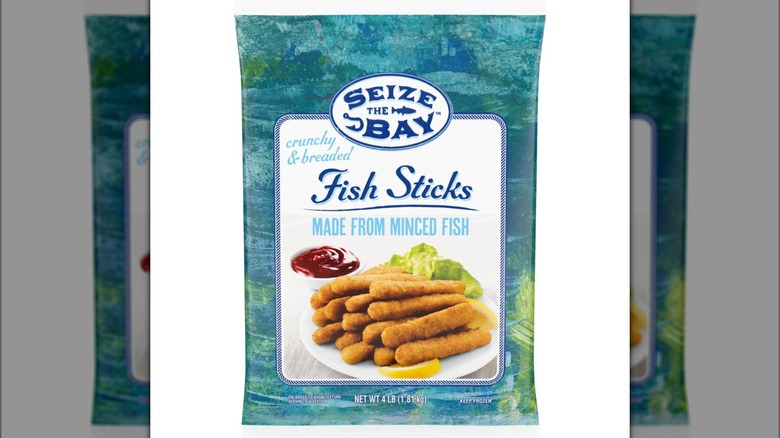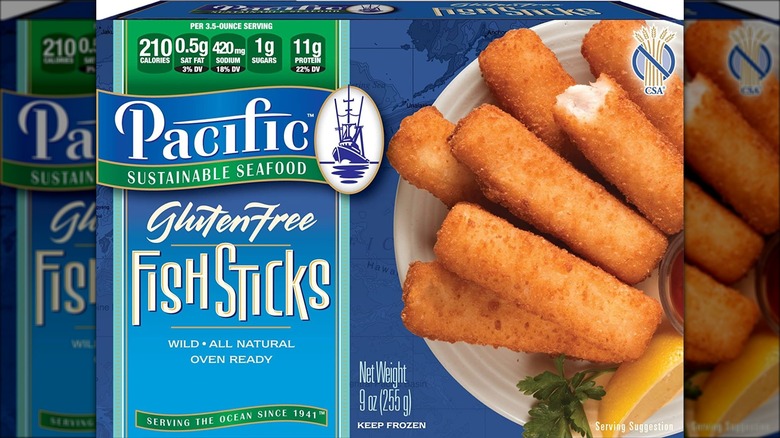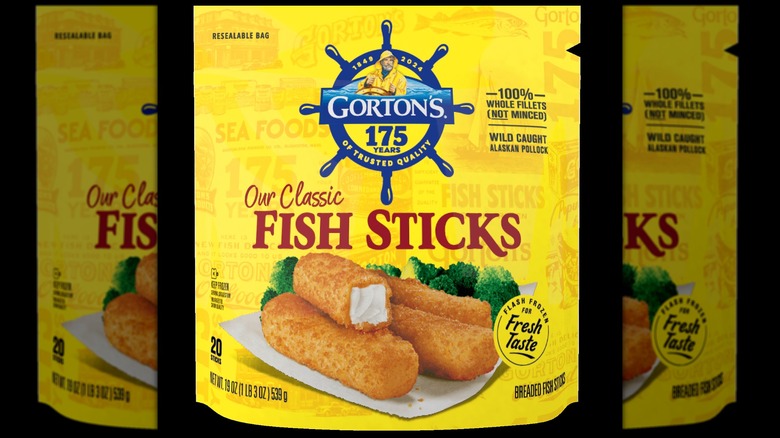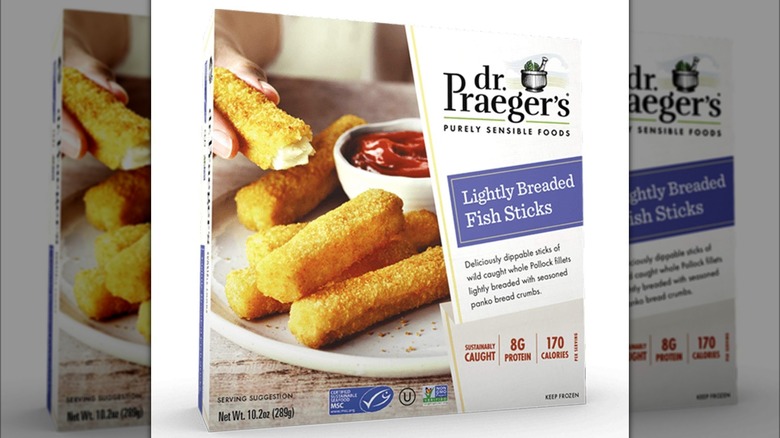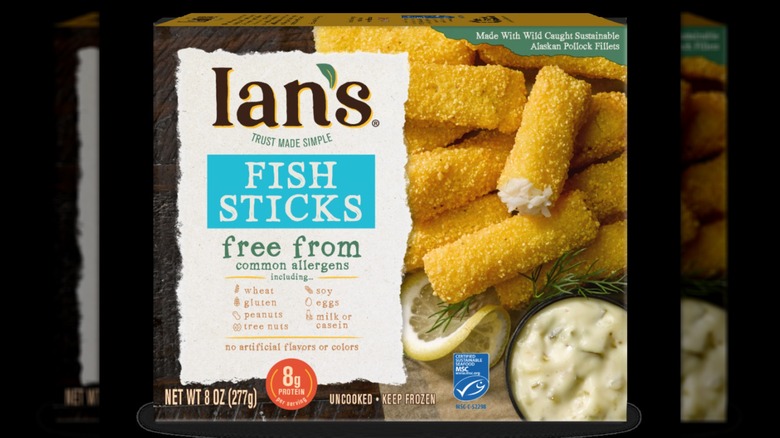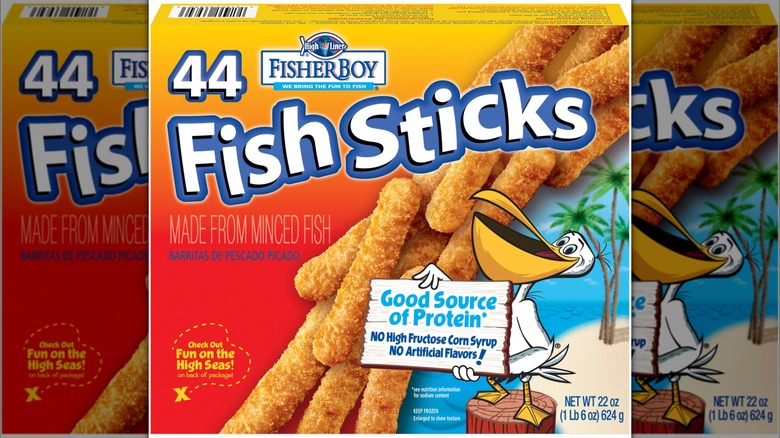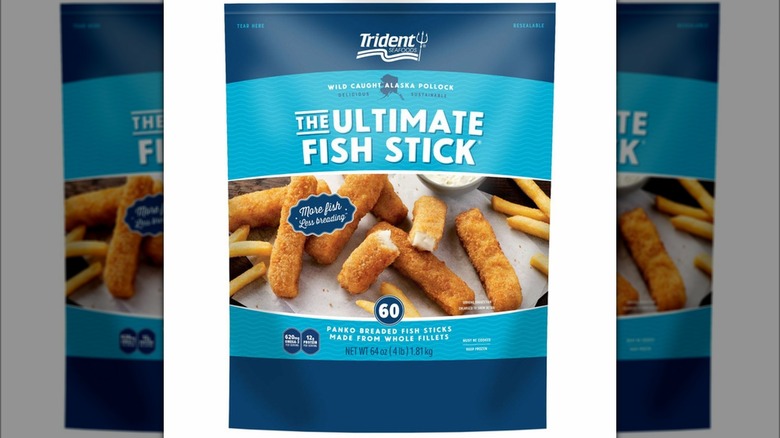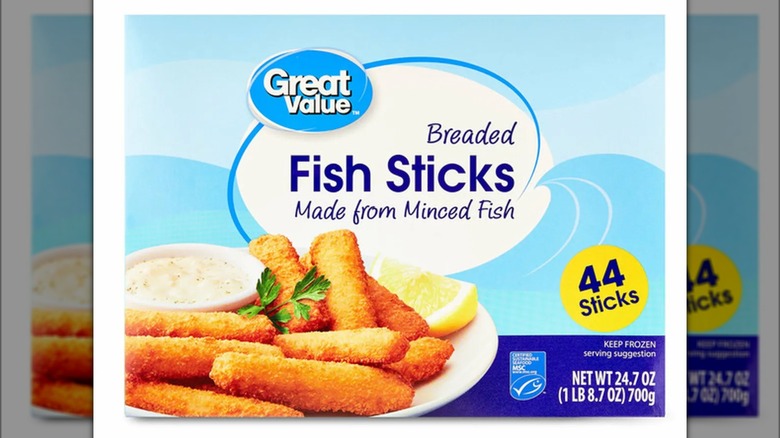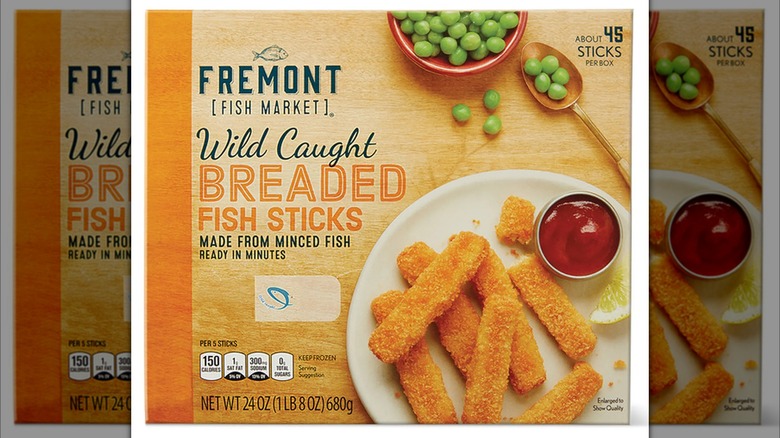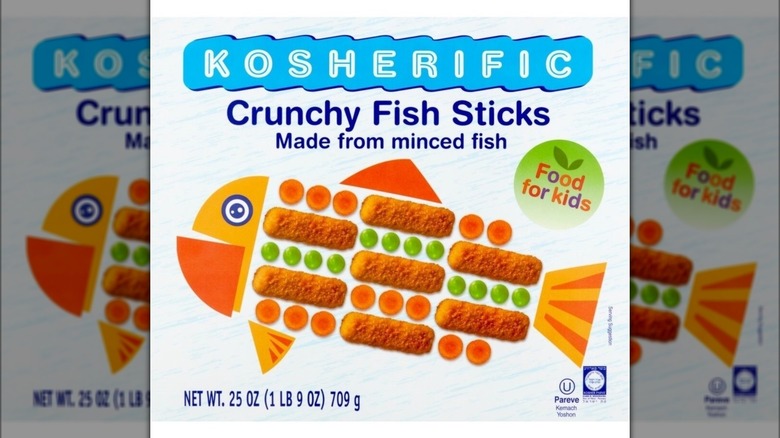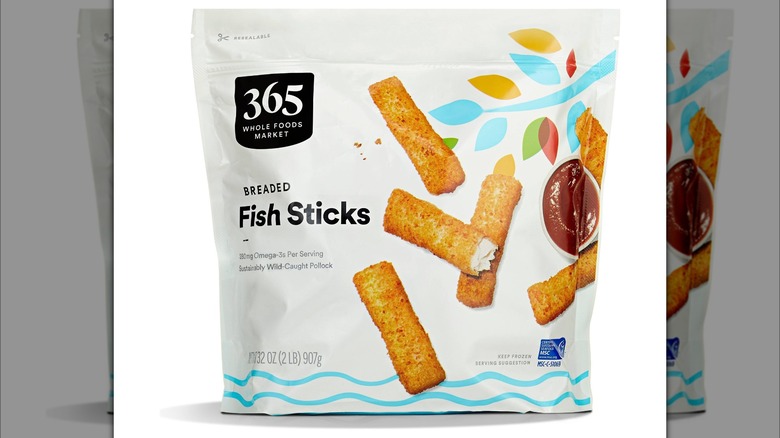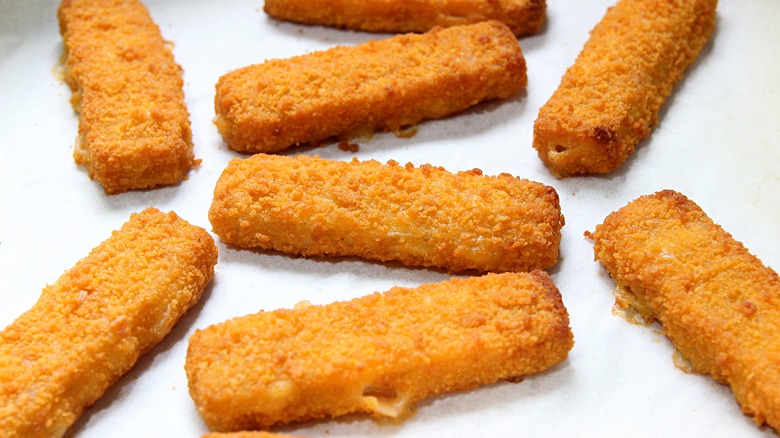Frozen Fish Sticks Made With The Highest And Lowest Quality Ingredients
We may receive a commission on purchases made from links.
If you're shopping for fish sticks, you've got your eyes on the prize: crispy, tender, and flavorful snacks you can nuke in under three minutes and dunk in your favorite sauce. They should feel as gloriously french-fried as possible, taste like actual fish, and do both of those things without any brow-raising ingredients. Don't want to dig through the grocery store freezer display to find the best brand? You've come to the right place.
Fish sticks (also known as fish fingers and filets) are the seafood for people who don't otherwise eat seafood. An exemplary masterclass in successful branding since 1953 — back when no one wanted to eat the new, odd-shaped frozen snack on the market — fish sticks have grown so omnipresent that historian Paul Josephson once called them "the ocean's hot dogs."
I took my guerilla-style label reading skills for a spin (I even put on my reading glasses for this, you guys) and leaned in for an ultra-close look at what goes into the recipes of these popular brands. As I discovered from my research, top-notch ingredients don't necessarily correlate to a crowd-pleasing bite. I am merely here for the packaging — you can be the judge on flavor. Gather 'round maties, these are some of the best (and worst) frozen fish sticks you can buy.
Lowest quality: Kroger crunchy fish filets
While Kroger's crunchy fish filets have crispy-sounding alliteration going for them, they quickly lose all credibility thanks to a higher-than-average sodium content, added sugar, and a bioengineered ingredient warning.
The brand boasts 9 grams of protein per two-filet serving (104 grams) from wild, sustainably-caught Pacific pollock. But that's where recognizable ingredients end and a complicated filet-shaped formulation begins. The 9 grams of fat likely comes from the vegetable oil blend, including soybean oil. While Kroger doesn't state which product on its ingredient list is genetically modified, this soybean oil may be a likely culprit; the FDA notes that most of soy grown in the U.S. is genetically modified and a large portion of it is used for oil.
Diving further into the nutrition label, 520 milligrams of sodium in just two filets clocks in at nearly double the amount of other brands on this list. A slew of preservatives, plus 2 grams of added sugar, put the cherry on top of a food that doesn't really need any added sugar in the first place.
Highest quality: Gardein plant-based f'sh filets
As one of the choice brands on this list, Gardein aims to reel in every vegan out there with its plant-based f'sh filets. Coming from the company that collabed on a pretty decent meatless pot pie I tasted once, I expected good things from this fishless f'sh.
First things first, this brand needs no safe fishing label since its main ingredient — textured vegetable protein — is derived from soybeans. With 9 grams of protein, 360 milligrams of sodium, and zero added sugar for every two-piece serving (96 grams), you can focus on the healthy dose of Omega-3s, and rest easy with no dairy or GMO ingredients.
This brand features a higher fat content than other brands at 13 grams per serving, with most of that coming monounsaturated fats. This fat can be beneficial in lowering bad cholesterol and boosting cell health. The ingredient list is rather massive, but, without any obvious red flags, Gardein's doing some of the best f'sh sticks in the industry — all without a single fish. Overall, it's a smart (and kosher) choice when it comes to balanced nutrition that's adjacent to the sea.
Lowest quality: Seize the Bay crunchy & breaded fish sticks
For the record, even lobster sometimes gets minced, so the "minced seafood blend" in Seize the Bay's crunchy & breaded fish sticks wasn't the scariest revelation on its packaging. However, there's likely nothing sustainably sourced about a mix of different fish — especially when there's no description of how these fish are caught.
Reports circulating online indicate that this pollock, whiting, cod, sole, and haddock fish stick's greatest blunder was its squishy, not-crunchy texture. But you can look to the nutrition label for even more bad news.
Along with the 12 grams of protein for every eight-stick serving (112 grams), you'll also get 580 milligrams of sodium — or 25% of the recommended daily value. For adults, the FDA recommends that sodium intake max out at no more than 2,300 milligrams per day. That's the equivalent of just 1 teaspoon of salt. Add to that 2 grams of sugar, plus a host of preservatives, and these little fish sticks start to look less appealing by the minute.
Highest quality: Pacific Seafood gluten-free fish sticks
Whip up a 3½ ounce (100g) serving of Pacific Seafood gluten-free fish sticks to get an easy 11 grams of protein — and no stomachaches, thanks to rice flour panko breading. This breading is even certified safe to eat by the National Celiac Association. Is it too good to be true? Well, it's a worthwhile buy if you don't mind the extra sodium.
Pacific Seafood fishes for compliments with labeling that shows it uses wild-caught, North Pacific pollock. It's a mission that the brand has stood by since it launched in 1941. The company has also earned certifications from the Marine Stewardship Council and the Aquaculture Stewardship Council, and partners with NOAA Fisheries, the Global Sustainable Seafood Initiative, and the James Beard Smart Catch Foundation.
The sodium content hits a bit higher than average at 420 milligrams per serving. But considering the sustainability factor, as well as fan-approved texture and flavor, this brand looks like a solid bet for fish sticks you can feel good about eating.
Lowest quality: Gorton's fish sticks
Taking another ride on the roller coaster of fried emotions, it's a low point for frozen fish with Gorton's fish sticks. From the brand that's been serving up the sea since 1849 comes minced, wild-caught pollock with a breading that's surprisingly crunchy for the microwaveable class. The kicker, however, is the ingredient list.
Along with the relatively substantial 10 grams of protein per four-stick serving (79 grams), you also get 430 milligrams of sodium and 1 gram of added sugar. But, looking past the warning label noting bioengineered ingredients in the coating, you'll see that the brand prominently states the use of vegetable oil. Of course it sounds healthy — it's from vegetables. Vegetables are good for you!
A slightly deeper dive into the nutrition label reveals that the vegetable oil comes from either canola oil, soybean oil, or both. While unsaturated fats in soybean oil have been proven to reduce bad cholesterol, there are also downsides. Soybean oil can trigger inflammation in the body (the same goes for canola oil), potentially expose you to harmful compounds known as aflatoxins, and growing the soybeans to make oil is associated with environmental concerns. There are definitely better-quality brands out there.
Highest quality: Dr. Praeger's lightly breaded fish sticks
Dr. Praeger's sources wild-caught Alaskan pollock and crafts its panko-breaded fish sticks with whole filets, rather than minced meat. The panko is made with wheat flour and therefore can't be called gluten-free. But, feel free to dive into a box of these babies if you're looking for snackable protein made with top-notch ingredients.
Zero added sugar, a low 250 milligrams of sodium, and 8 grams of protein per three-stick serving (81 grams) only add to the delightfully simple list of ingredients. You'll see expeller-pressed canola oil listed last on the label; it's a method that utilizes physical pressure instead of chemical extraction to derive the oil from plants. It's a slower, more expensive process that results in a higher-quality oil.
Even better, sustainability designations are clearly printed on the packaging. The kosher-certified, Non-GMO Project Verified recipe is also certified by the Marine Stewardship Council. Having been founded by actual doctors back in the '90s, Dr. Praeger's remains focused on healthifying the most indulgent snacks on the market.
Lowest quality: Van de Kamp's crunchy breaded fish sticks
This brand falls into the category of having too much sodium and added sugar to make a middle-of-the-road fish stick worth it. Van de Kamp's crunchy breaded fish sticks did its homework on environmental stewardship and then dropped the ball on the nutrition end of things.
The packaging boasts healthy Omega-3 fats, 100% wild-caught pollock, traceability of its fishing pipeline, and a sustainability certification from the Marine Stewardship Council. Plus, 10 grams of protein per six-stick serving (95 grams) offers a satisfying snack as far as fish sticks go.
But 440 milligrams of sodium tips the higher end of the scale. You'll also find soybean oil listed high in the ingredients lineup, along with other less-recognizable additives like ferrous sulfate. This iron-boosting mineral is commonly used to enrich foods, but here it only squeaks in 0.6 milligrams of iron per serving (or 4% of the recommended daily intake for adults).
Highest quality: Ian's fish sticks
Ian's fish sticks gets plenty of good ratings from fans — and not just because its product is gluten-free (Hey, Ian's, you should put that in bolder print on the label). In fact, the recipe is free from some of the major allergens and has a minimal ingredient list.
A serving of five Ian's fish sticks offers 8 grams of protein and just 210 milligrams of sodium. The brand also sources whole Alaskan pollock filets and keeps the cane sugar and the expeller-pressed canola oil in the breading to a minimum.
The fish is sustainably wild-caught, with a designation from the Marine Stewardship Council, and the list of non-allergens covers just about everything (even soy, which seems to pop up on almost every other ingredient list). Plus, this product features no artificial flavors or colors. Okay, there's one warning to note before you dust up your plate with Old Bay seasoning: Anyone with a fish allergy should probably avoid this brand (Just in case any fish stick lawyers are reading this).
Lowest quality: Fisher Boy fish sticks
I have nothing against the low price of Fisher Boy's fish sticks, but you probably shouldn't go to the dollar store with visions of sustainably-caught fish sticks dancing in your head. Fisher Boy's fish sticks go light on the wallet, and very heavy on the sodium and added sugar.
With eight of these fish sticks making up a single 104-gram serving, they eat more like fried straws than fresh filets from the sea. Speaking of that, the minced fish blend features pollock, cod, sole, and haddock. So where do these fish come from? The packaging features an illustrated spokespelican named Telly the Pelly, along with a blue fish logo on the back of the box that reads "responsibly sourced." Having never seen one of these before, I researched the parent company, High Liner Foods, to discover that this designation means that 96% of the company's fishing meets the responsibility standards established by ... High Liner itself. Hmm. Granted, I would also give myself an A for fish sticks.
On the nutrition panel, you'll find 12 grams of protein per serving along with an eye-popping 640 milligrams of sodium. Among a list of several bajillion ingredients (I didn't count them all), with many classifying as preservatives, 2 grams of added sugar tip the scale in favor of never buying this brand.
Highest quality: Trident Seafoods The Ultimate Fish Stick
Well, "ultimate" sure sets the bar pretty high. Spot-on breading might be a priority when it comes to fried fish, but Trident Seafoods' The Ultimate Fish Stick is all about using as little breading — and as much fish — as possible. Don't worry, the package features more than one ultimate stick.
Hitting the high end of this list with 12 grams of protein per three-stick serving (85 grams), sustainably-caught, wild Alaska pollock makes up 65% of each fish stick. This is more fish than the industry standard of 50%. The sodium content lands at 320 milligrams, which isn't low, but also isn't the highest among the brands I reviewed. The ingredient rundown is long and indulgent when you consider the batter and breading, but all of those seasonings and stabilizers come with zero added sugar.
Sustainability also features prominently in Trident Seafoods' brand mission. Nearly all of its fisheries are certified via the Global Sustainable Seafood Initiative, as well as the Marine Stewardship Council, Alaska's Responsible Fisheries Management program, and the Aquaculture Stewardship Council. Dig in.
Lowest quality: Great Value breaded fish sticks
While Walmart strikes the right chord on affordability, its in-house brand doesn't always pass the test when it comes to nutrition. Great Value's breaded fish sticks look like a steal, but pack a decently high sodium content and more than a few ingredients that count as common allergens.
Alaska pollock gets the minced treatment for these fish sticks, which feature 10 grams of protein per seven-stick serving (111 grams). Still, 530 milligrams of sodium knocks this one off its feet. Beyond the warning label alerting shoppers to bioengineered ingredients, you'll find a vegetable oil blend of canola, cottonseed, and/or soybean oils. After that, head on down to the list of possible trace allergens which includes everything from soy and shrimp to coconut, pecans, and sesame.
This brand clearly sports the Certified Sustainable Seafood label from the Marine Stewardship Council. But, you can easily enjoy a flavorful, crispy fish stick from another brand on this list that features much less sodium.
Highest quality: Aldi Fremont Fish Market wild-caught breaded fish sticks
Aldi enters the chat with its private-label Fremont Fish Market, which is home to a customer-favorite line of seafood-based snacks. Fremont Fish Market's wild-caught breaded fish sticks are no exception. The brand's offerings include what might be the only minced pollock on this list — and one that still reportedly retains the bite appeal of a whole filet.
This brand comes in a little lower than average on protein, at 7 grams for each five-stick serving (78 grams), when compared to other high-quality frozen fish sticks. The sodium content reaches 300 milligrams per serving, and a vegetable oil blend from the usual suspects (canola, cottonseed, and soybean) raises a tiny red flag, but still makes this recipe deliciously greasy and very finger food-esque.
Where Fremont Fish Market really shines is in its sustainability. Like official certifications? The brand boasts designations from the Marine Stewardship Council, the Aquaculture Stewardship Council, and the Responsible Fishing Vessel Standard program. While many of us might buy this brand just because it's Aldi, it's nice to know there's responsible fishing behind your new favorite fish sticks.
Lowest quality: Kosherific crunchy fish sticks
This brand immediately has me considering the cooking standards behind the kosher diet in Judaism, but even with those strict regulations, Kosherific's Crunchy Fish Sticks didn't quite make the cut. The amount of sodium in these sticks is decidedly not "kosherific" — especially because the brand appears to be marketed toward kids.
On the plus side, the Kosherific Co. is indeed kosher. The minced fish blend features a palate-tingling medley of whiting, pollock, carp, whitefish, and pike; it's a departure from the usual blend of minced varieties on this list. The jury's still out on whether this difference is detectible on the tongue. But the 10 grams of protein per six-stick serving (88 grams) get lost in translation when you note the accompanying 440 milligrams of sodium.
Also odd for a children's fish stick is the list of notorious allergens. With many kid-friendly food brands clamoring all over each other to be the least offensive option for upset-tummy Timmy, Kosherific Crunchy Fish Sticks doesn't appear to be too concerned about wheat, gluten, soy, and corn products being featured in its fish snack.
Highest quality: 365 breaded fish sticks
Leave it to the Whole Foods Market's 365 brand to nail maximum protein and Earth-friendly fishing. Whole Foods 365's breaded fish sticks brings its A-game with a healthy dose of Omega-3s from sustainably sourced, wild-caught pollock.
Pollock may be the same species McDonald's uses in its fish sandwich, but this modest white fish features a mild, slightly sweet and savory flavor that proves to be a clear winner with fans. At 320 milligrams of sodium per five-stick serving (105 grams), this brand lands in the middle of the pack. It packs a healthy punch of Omega-3s in every serving. This fatty acid may help regulate blood pressure, increase brain activity, reduce the occurrence of stroke and heart disease, and mitigate illnesses like dementia, depression, migraine, asthma, and inflammation.
A Marine Stewardship Council certification placed on the front of the package means these fish sticks come to you through responsible channels. As for what you should do with your new fish stick superpowers, just try not to get tartar sauce all over the couch cushions.
Methodology
Before you dive headfirst into the taste-testing phase, you can easily compare the ingredients and nutrition info for any fish stick brand by looking at its packaging in-person or on the Internet. Using my armchair dietician knowledge (full confession, it's a La-Z-Boy with a gym membership), I scrutinized each label for high-quality ingredients and prioritized sustainable, responsible sourcing — because we all want to eat food that tastes good and feels good, too.
Want to upgrade your fish sticks? Wrap them in a tortilla and call it taco night done right.

